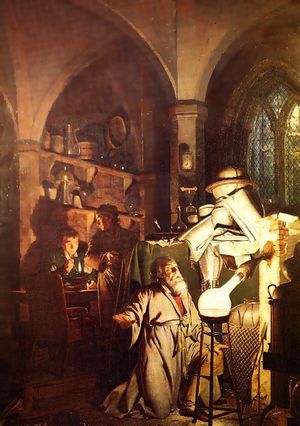حجر الفلاسفة

حجر الفلاسفة (لاتينية: lapis philosophorum) هو مادة اسطورية يُعتقد أنها تستطيع تحويل الفلزات الرخيصة (كالرصاص) إلى ذهب ويمكن استخدامه في صنع إكسير الحياة. إن أصل هذا المصطلح هو في علم الخيمياء الذي بدأ في مصر القديمة ولكن فكرة تحويل المعادن إلى معادن أغلى (كالذهب أو الفضة) تعود إلى كتابات الخيميائي العربي جابر بن حيان. قام ابن حيان بتحليل خواص العناصر الاربعة بحسب أرسطو قائلا بوجود اربعة خواص اساسية الحر والبرودة والجفاف والرطوبة. وقد اعتبر النار حارة وجافة أما التراب فبارد وجاف بينما الماء بارد ورطب والهواء حار و رطب. فذهب إلى القول ان المعادن هي خليط من هذه العناصر الاربعة اثنان منهما داخليا واثنان خارجيا. ومن فرضيته تلك تم الاستنتاج ان تحويل معدن إلى اخر ممكن من خلال اعادة ترتيب هذه الخواص الاساسية. ان هذا التحول، بحسب اعتقاد الخيميائيين، سيكون بواسطة مادة سموها الاكسير. وقد قال البعض ان الاكسير هو مسحوق احمر لحجر اسطوري - حجر الفلاسفة.
يعتقد البعض ان ابن حيان قد استمد مفهومه لحجر الفلاسفة من معرفته بامكانية اخفاء المعادن كالذهب والفضة في أشابات واستخراجها منها لاحقا بمعالجة كيماوية. كما كان جابر بن حيان مخترع الماء الملكي (مزيج من حمض النيتريك وحامض الهيدروكلوريك) أحد المواد القليلة التي تستطيع إذابة الذهب (ولا يزال قيد الاستعمال لتنظيف الذهب).
اعتقد الأقدمون أن الذهب فلز لا يصدأ ولا يفقد بريقه أو يفسد. وبما ان حجر الفلاسفة تحول معدن قابل للفساد إلى معدن غير قابل للفساد استنتجوا انه يستطيع منح الانسان المخلوق الفاني الخلود. وقد ساد هذا الاعتقاد في القرون الوسطى بالذات.
بقي الايمان بحجر الفلاسفة سائدا إلى ان قام أنطوان لاڤوازييه باعادة تعريف مصطلح العنصر.
التاريخ
ذكر حجر الفلاسفة في كتابات وجدت ترجع زمنيا إلى شايروكميتا إلى Zosimos of Panopolis (c. 300 ميلادية.)[1] الكتاب الخيميائيين قد عينوا التاريخ. الياس Ashmole ومؤلف مجهول غلوريا موندي (1620) مع الادعاء بأن تاريخها يعود إلى آدم الذي حاز المعرفة عن الحجر مباشرة من الله. وقيل أن هذه المعرفة تنتقل من خلال الأنبياء، مما يعطيهم طول العمر.وتقارن أسطورة الحجر بالتاريخ التوراتى لهيكل سليمان والحجر المرفوض المذكور في مزمور 118]].[2]
The theoretical roots outlining the stone’s creation can be traced to Greek philosophy. Alchemists later used the Classical elements, the concept of anima mundi, and Creation stories presented in texts like Plato’s Timaeus as analogies for their process.[3] According to Plato, the four elements are derived from a common source or prima materia (first matter), associated with chaos. Prima materia is also the name alchemists assign to the starting ingredient for the creation of the philosopher’s stone. The importance of this philosophical first matter persisted through the history of alchemy. In the seventeenth century, Thomas Vaughan writes, “the first matter of the stone is the very same with the first matter of all things”.[4]
العملية الخيميائية
اللوح الزمردي هو أقدم وثيقة[5] التي تعطي "وصفة" لعمل الحجر.
وحسب هذا الوصف، which was taken as the basis of numerous later works, the procedure consists of seven stages:
- 1. solutio or liquefactio, the "dissolution" or "liquidation" of the materia prima
- 2. putrefactio, also nigredo, a "blackening" or a descent into the nether sphere in which the materia becomes black or putrid. This stage is symbolized by the raven and by the burial of a dead body in the earth.
- 3. albedo or "lightening", the putrid or blackened substance is made white or pure once again, symbolized by the transition of the raven into a white dove.
- 4. citrinitatio or "yellowing". The materia must be re-enriched by "philosophical milk" or lacta philosophica, the completion of which is indicated by the assumption of a yellow colour, symbolized as cauda pavonis or peacock's tail.
- 5. destillatio, or "reddening", symbolized by a red dragon
- 6. coagulatio or fixatio, a coagulation or solidification of the materia
- 7. tinctura, the completion of the lapis
Other sources name twelve stages, the first seven corresponding to those above, but with an added five steps following the production of the tinctura:
- 1. calcinatio (solidification by fire, ruled by Mercury),
- 2. putrefactio or mortificatio (purification by decay of the impure components, ruled by Saturn),
- 3. sublimatio (sublimation of the materia into volatile form, symbolized by a chalice or a raven's head on which a little white bird is sitting, ruled by Jupiter)
- 4. solutio (symbolized by the "silver queen" riding a griffin, ruled by the Moon)
- 5. distillatio (ruled by Venus)
- 6. coagulatio (symbolized by hieros gamos, by an androgynous figure or a combination of a unicorn and a stag, ruled by Mars)
- 7. extractio (ruled by the Sun)
- 8. digestio
- 9. ceratio
- 10. fermentatio
- 11. multiplicatio
- 12. projectio, the final transmutation of the base metal into gold.[6]
انظر أيضاً
الهامش
- ^ Andrew Ede, Lesley B. Cormack. A History of Science in Society: from philosophy to utility. University of Toronto Press. p .66
- ^ رافائيل باتاي. والكيميائيون اليهودي: كتاب التاريخ والمصدر مطبعة جامعة برينستون, 1995. p.19
- ^ Stanton J. Linden. The alchemy reader: from Hermes Trismegistus to Isaac Newton Cambridge University Press. 2003. p. 29.
- ^ Mark Haeffner. Dictionary of Alchemy: From Maria Prophetessa to Isaac Newton. Karnac Books, 2004. p.211
- ^ it is unclear if the text originates in the Middle Ages or in Late Antiquity, but ويـُعتقد عموماً بأن تاريخها يعود لما قبل 1150، عندما ترجمها جرارد من كرمونا من العربية (Mircea Eliade, History of Religious Ideas, vol. 3/1)
- ^ H. Biedermann, Lexikon der magischen Künste (1998), p. 407.